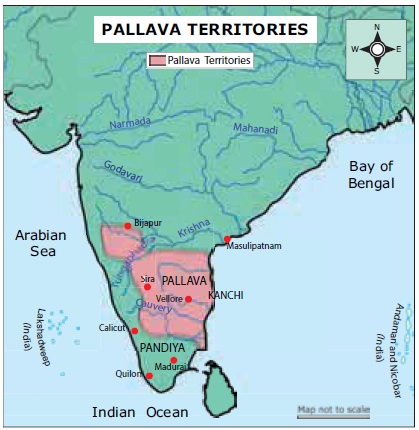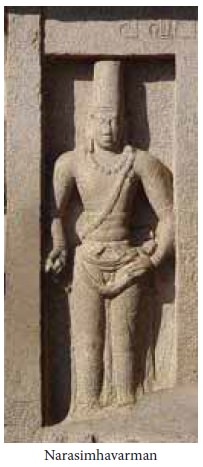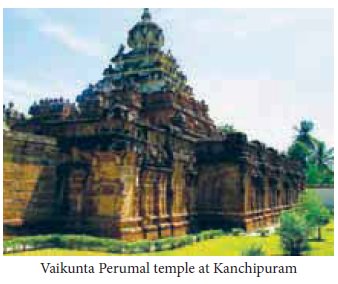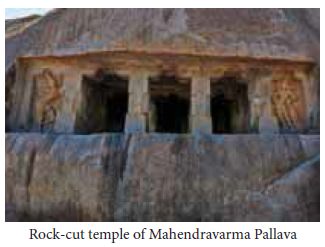South India | History - Pallavas | 11th History : Chapter 9 : Cultural Development in South India
Chapter: 11th History : Chapter 9 : Cultural Development in South India
Pallavas
Pallavas
There is no scholarly consensus about the origin of the Pallavas. Some early scholars held the view that the word Pallava was a variant of Pahlava, known as Parthians, who moved from western India to the eastern coast of the peninsula, during the wars between the Sakas and the Satavahanas in the second century CE. But many scholars today regard them native to south India or “with some mixture of north Indian blood”.

The Pallavas were associated with Tondaimandalam, the land between the north Pennar and north Vellar rivers. Simhavishnu is believed to have conquered the Chola country up to the Kaveri and consolidated his dynastic rule, started by his father Simhavarman. Simhavishnu, vanquishing the Kalabhras, conquered the land up to the Kaveri, thereby coming into conflict with the Pandyas. Simhavishnu’s successor Mahendravarman I (590-630), whom Appar, converted from Jainism to Saivism, was a patron of arts, and a poet and musician in his own right.
During Mahendravarman’s reign, the army of Pulikesin II annexed the northern part of Pallava kingdom and almost reached the Pallava capital of Kanchipuram.

Subsequently, during the reign of Narasimhavarman I (630-668), the Pallavas managed to settle scores by winning several victories over the Chalukyas with the aid of their ally Manavarman, a Sri Lankan prince, who later became ruler of the island kingdom. The climax was Narasimhavarman’s invasion of the Chalukyan kingdom and his capturing of the Badami. Narasimhavarman claims to have defeated the Cholas, Cheras and Kalabhras. Two naval expeditions despatched to help Manavarman were successful, but this Sri Lankan ruler subsequently lost his kingdom.
The Pallava-Chalukya conflict continued during the subsequent decades, with some intermittent peace. During the reignofhisgrandson,ParamesvaravarmanI (670-700), Vikramaditya of the Chalukya kingdom invaded the Pallava country. Paramesvaravarman fought against him with the support of the Gangas and Pandyas. As a result, the Pallavas came into conflict with the Pandyas in the south. In the early ninth century, the Rashtrakuta king, Govind III, invaded Kanchi during the reign of the Pallava Dantivarman. Dantivarman’s son Nandivarman III aided by western Gangas and Cholas, defeated the Pandyas at the battle of Sripurambiyam or Thirupurambiyam. Aparajita, grandson of Nandivarman III, lost his life in a battle fought against Aditya I of the Chola kingdom who invaded Tondaimandalam. This sealed the fate of the Pallavas. Thereafter, control over Tondaimandalam passed into the hands of the Cholas.
Pallava Administration
Under the Pallavas, kinship was held to be of divine origin and was hereditary. The king took high-sounding titles, some of which, such as maharajadhiraja, were borrowed from north Indian traditions. The king was assisted by a group of ministers, and in the later Pallava period this ministerial council played a prominent part in state policy. Some of the ministers bore semi-royal titles and may well have been appointed from among the feudatories.
Distinctions are made between amatyas and mantrins. While a mantri is generally understood to be a diplomat, amatya is a counsellor. Mantri Mandala was a council of ministers. Rahasyadhikrita was a private secretary of the king. Manikkappandaram-Kappan was an officer in charge of the treasury (Manikka - valuables; Pandaram - treasury; Kappan – keeper). Kodukkappillai was the officer of gifts. They were central officers under the Pallava king. Kosa-adhyaksa was the supervisor of the Manikkappandaram-kappan. Judicial courts were called Adhikarna Mandapa and judges called Dharmadhikarins. Fines are mentioned in the Kasakudi plates of Nandivarman Pallava as Karanadandam (fine in superior/ higher court) and Adhikaranadandam (fine in district level).
The governor of a province was advised and assisted by officers in charge of districts who worked in close collaboration with local autonomous institutions, largely in an advisory capacity. They were built on local relationship of caste, guilds, craftsmen and artisans (such as weavers and oil-mongers), students, ascetics and priests. There were assemblies of villagers and also representatives of districts. General body meetings of the assembly were held annually, and meetings of smaller groups were responsible for implementing policy.
Land Grants
Land ownership was with the king, who could make revenue grants to his officers and land-grants to Brahmans, or else continue to have land cultivated by small-scale cultivators and landlords. The latter was the most common practice. Crown lands were leased out to tenants-at-will. The status of the village varied according to the tenures prevailing. The village with an inter-caste population paid land revenue. The brahmadeya villages were donated to a single Brahman or a group of Brahmans. These villages tended to be more prosperous than the others because no tax was paid. There were devadana villages, donated to a temple, and the revenue was consequently received by the temple authorities and not by the state. The temple authorities assisted the village by providing employment in the service of the temple. This last category of villages gained greater significance when in later centuries the temples became the centres of rural life. During the Pallava period the first two types of villages were predominant.
Village Life
In the village, the basic assembly was the sabha, which was concerned with all matters relating to the village, including endowments, land, irrigation, cultivated, punishment of crime, the keeping of a census and other necessary records. Village courts dealt with petty criminal cases. At a higher level, in towns and districts, courts were presided over by government officers, with the king as the supreme arbiter of justice. The sabha was a formal institution but it worked closely with the urar, an informal gathering of the entire village. Above this was a district council which worked with nadu or district administration. Villages populated entirely or largely by Brahmans preserved records of the functioning of assemblies and councils. The link between the village assembly and the official administration was the headman of the village.
Tank Irrigation
A special category of land, eripatti or tank land, was known only in south India. This land was donated by individuals, the revenue from which was set apart for the maintenance of the village tank. Rainwater was stored in the tank so that land could be irrigated during the annual long, dry spell. The tank, lined with brick or stone, was built through the cooperative effort of the village, and its water was shared by all cultivators. The maintenance of these tanks was essential to the village. Practically every inscription from the Pallava period pertaining to the rural affairs refers to the upkeep of the tank. Next in importance came wells. Water was distributed by canals, which were fitted with sluices to regulate the water level and prevent overflowing at the source. The distribution of water for irrigation was supervised by a special tank committee appointed by the village. Water taken in excess of allotted to a particular cultivator was taxed.
Revenue and Taxation
Land grants recorded mainly on copperplates provide detailed information on land revenues and taxation.

Revenue came almost exclusively from rural sources, mercantile and urban institutions being largely unplanned. Two categories of taxes were levied on the village. The land revenue paid by the cultivator to the state varied from 1/6th to 1/10th of the produce, and was collected by the village and paid to the state collector. In the second category were local taxes, also collected in the village but utilized for services in the village itself. The tax money was spent for repairing irrigation works, illuminating the temple, etc. When the state land tax was inadequate, the revenue was supplemented by additional taxes on draught cattle, toddy-drawers, marriage-parties, potters, goldsmiths, washermen, textile-manufacturers, weavers, brokers, letter-carriers, and the makers of ghee.
The loot and booty obtained in war added to the revenue of the state. Pallava considered war to be very important and a series of sculptures depicting the important events connected with the reign of Nandivarama Pallava, notably Pallava troops attacking a fort are seen in the Vaikunta Perumal temple at Kanchipuram. This fort is depicted in the sculptures as having high ramparts with soldiers attacking it and elephants standing near it.
Pallava Army
Much of the state revenue went to maintain the army. The king maintained a standing army under his direct control. The army consisted of foot-soldiers, cavalry and a small force of elephants. Chariots were by now almost out of use and in any case were ineffective in the hilly terrains, as much of the fighting took place there. Cavalry, though effective, was expensive, as horses had to be imported. The Pallavas developed a navy and built dockyards at Mamallapuram and Nagapattinam. However, the Pallava navy was inconsiderable compared to the naval strength of the Cholas who succeeded them.
Trade
Kanchipuram was an important trading centre in the Pallava period. The merchants had to obtain license to market their goods. Barter system generally prevailed but later the Pallavas issued gold and silver coins. Merchants had their own organizations such as Manigramam. In foreign trade, spices, cotton textiles, precious stones and medicinal plants were exported to Java, Sumatra, Cambodia, Sri Lanka, China and Burma. Mamallapuram was an important seaport.
Traders founded guilds and called themselves as sudesi, nanadesi, ainurruvar and others. Their main guild functioned at Aihole. Foreign merchants were known as Nanadesi. It had a separate flag with the figure of bull at the centre, and they enjoyed the right of issuing vira-sasanas. The jurisdiction of this guild stretched over entire south-east Asia. The chief of this guild is registered in the inscriptions as pattanswamy, pattnakilar, and dandanayaka. Its members were known as ayyavole-parameswariyar.
Maritime Trade
Unlike in the Ganges plain, where large areas were available for cultivation, the regions controlled by the Pallavas and the Chalukyas commanded a limited income from land. Mercantile activity had not developed sufficiently to make a substantial contribution to the economy. The Pallavas had maritime trade with south-east Asia, where by now there were three major kingdoms: Kambuja (Cambodia), Champa (Annam), and Srivijaya (the southern Malaya peninsula and Sumatra). On the west coast, the initiative in the trade with the West was gradually passing into the hands of the foreign traders settled along the coast, mainly Arabs. Indian traders were becoming suppliers of goods rather than carriers of goods to foreign countries, and communication with the west became indirect, via Arabs, and limited to trade alone.
Society
Brahmins as learned scholars in literature, astronomy, law and others functioned as the royal counsellors. Not only were they in the teaching profession, they were also involved in agriculture, trade and war. They were exempted from paying taxes and capital punishment. The next important social group which ruled the state was called sat-kshatryas (quality kshatriyas). Not all the kshatryas were of warring groups; some of them were involved in trading as well. They also enjoyed the right to read the Vedas, a privilege denied to lower varnas. The trading group maintained warriors for protection and founded trade guilds. The people who were at the bottom of the society worked in agriculture, animal husbandry, and handicraft works. People engaged in scavenging, fishing, dry-cleaning and leather works were positioned outside the varna system.
Most scholars agree that Aryanisation or the northern influence on the south picked up pace during the Pallava period. This is evident from the royal grants issued by the kings. The caste structure had firmly established. Sanskrit came to be held in high esteem.
Kanchipuram continued to be a great seat of learning. The followers of Vedic religion were devoted to the worship of Siva. Mahendravarman was the first, during the middle of his reign, to adopt the worship of Siva. But he was intolerant of Jainism and destroyed some Jain monasteries. Many of the great Nayanmars and Alwars, Saiva and Vaishanava poet-saints lived during his time. Buddhism and Jainism lost their appeal. However, Hiuen-Tsang is reported to have seen at Kanchi one hundred Buddhist monasteries and 10,000 priests belonging to the Mahayana school.
Growing influence of Brahmanism
Perhaps the most obvious sign of the influence of Aryan culture in the south was the pre-eminent position given to Brahmins. They gained materially through large gifts of land. Aryanisation is also evident in the evolution of educational institutions in the Pallava kingdom. In the early part of this period education was controlled by Jains and Buddhists, but gradually the Brahmins superseded them. The Jains who had brought with them their religious literature in Sanskrit and Prakrit, began to use Tamil. Jainism was extremely popular, but the competition of Hinduism in the succeeding centuries greatly reduced the number of its adherents. In addition, Mahendravarman I lost interest in Jainism and took up the cause of Saivism, thus depriving the Jains of valuable royal patronage. The Jains had developed a few educational centres near Madurai and Kanchi, and religious centres such as the one at Shravanabelagola in Karnataka. But a vast majority of the Jaina monks tended to isolate themselves in small caves, in hills and forests.
Monasteries and Mutts
Monasteries continued to be the nucleus of the Buddhist educational system and were located in the region of Kanchi, and the valleys of the Krishna and the Godavari rivers. Buddhist centres were concerned with the study of Buddhism, particularly as this was a period of intense conflict between orthodox and heterodox sects. But Buddhism was fighting a losing battle. Royal patronage, which the Buddhists lacked, gave an edge to the protagonists of Vedic religions.
Apart from the university at Kanchi, which acquired a fame equal to that the Nalanda, there were a number of other Sanskrit colleges. Sanskrit was the recognized medium, and was also the official language at the court, which led to its adoption in literary circles. In the eighth century the mathas (mutts) became popular. This was a combination of a rest house, a feeding-centre, and an education centre, which indirectly brought publicity to the particular sect with which it was associated.
Growing Popularity of Sanskrit
Mahendravarman I composed Mathavilasa Prahasanam in Sanskrit. Two extraordinary works in Sanskrit set the standard for Sanskrit literature in the south: Bharavi’s Kiratarjuniya and Dandin’s Dashakumaracharita. Dandin of Kanchipuram, author of the great treatise on rhetoric Kavyadarsa, seems to have stayed in Pallava court for some time.
Rock-cut Temples
Mahendravarman I is credited with the introduction of rock-cut temples in the Pallava territory. Mahendravarman claims in his Mandagappattu inscription that his shrine to Brahma, Isvara and Vishnu was made without using traditional materials such as brick, timber, metal and mortar. Mahendravarman’s rock temples are usually the mandapa type with a pillared hall or the mandapa in front and a small shrine at the rear or sides.

Related Topics